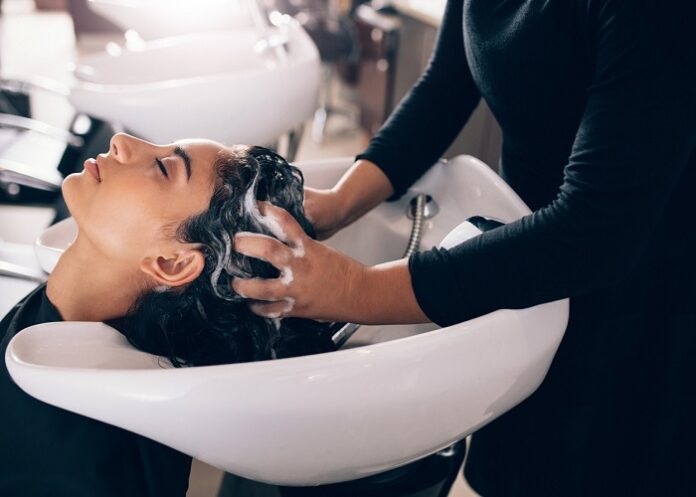A rare condition known as beauty parlour stroke syndrome (BPSS) can, for a small number of people, make a routine shampooing at the hairdresser a serious health threat, according to experts.
In The Conversation, neuroscience lecturer Maria Ashioti writes that a trip to the salon could turn into a health emergency, that research suggests sitting at an awkward angle at the backwash basins, used in many salons, can cause neck pain, injury and – on very rare occasions – even a life-threatening stroke.
BPSS was first identified in 1993 by American neurologist Michael Weintraub, who found that some of his patients had developed severe stroke-related symptoms after having their hair shampooed during a visit to a hairdresser.
A stroke is a brain attack caused by a sudden reduction in blood flow to the brain – usually caused by a blockage from a blood clot or the tearing and bursting of a major blood vessel in the brain, leading to a reduction of oxygen, glucose and nutrients that damages and kills brain cells.
During the shampooing process, clients are usually asked to sit and hang their head back over the edge of the basin. Research suggests that over-extending the head and neck over the rigid rim of the sink is the primary cause of BPSS.
The unusual neck position, neck rotation or sudden jerking movements during vigorous shampooing, can cause the backbones of the higher spinal column around the neck area to push against one of the major blood vessels that supply blood to the back and bottom of the brain.
Some cases of BPSS have also been caused by bone spurs – tiny bone fragments from lumps on the spine – that can either compress or tear the artery next to them.
Strokes are often associated with older people and those with medical issues like high blood pressure, diabetes or high cholesterol, but young, healthy people can have strokes too.
While research suggests BPSS is most likely to occur in women over 50 – and previous history of narrowing or thinning of blood vessels and arthritis of the spinal column in the neck are particular risk factors – it could happen to anyone regardless of age or medical history.
A 2016 Swiss study found only 10 instances of BPSS during 2002-2013 so, although BPSS is much rarer than conventional stroke, it’s still important to be aware of the symptoms.
Signs include headache, light-headedness, dizziness, blurred or narrowed vision, nausea, vomiting, pain in the neck and some paralysis on one side of the body, and some patients also report a near loss of consciousness.
Studies suggest that these symptoms may be delayed, making it difficult for doctors to diagnose BPSS rather than a conventional stroke.
Maria Ashioti, Senior Lecturer, Neuroscience, Inflammatory Disorders and Therapeutics, University of Westminster, UK.
Study details
Beauty parlour stroke revisited: An 11-year single-centre consecutive series
Pamela Correia, Ivo Meyer, Patrik Michel et al.
Published in International Journal of Stroke in April 2016
Abstract
Background
Hairdresser-related ischaemic cerebrovascular events (HICE) are attributed to compression of vertebral arteries or cervical artery dissections. We determined their frequency, mechanisms, localisation and outcome in a pre-specified study.
Methods
We prospectively collected ischaemic strokes and transient ischemic attacks occurring in relation to a hairdresser visit from 2002 to 2013, using consecutive data from an ischaemic stroke registry (ASTRAL). HICE were compared to all other acute ischaemic strokes in ASTRAL.
Results
We identified 10 HICE (9 strokes and 1 transient ischaemic attack). Age and anterior-posterior distribution were similar with a significantly higher rate of females (90% vs. 43%, p = 0.02) in the HICE group compared to ASTRAL. Patients with HICE had significantly lower incidence of hyperlipidemia (30% vs. 73%) and diabetes (0% vs. 19%). The mechanisms of HICE were diverse: carotid artery dissection (n = 2), cardiac (n = 2), lacunar (n = 2), other determined (n = 2) and unknown etiology (n = 2). Two HICE with atherosclerotic intracranial disease were possibly caused by acute haemodynamic changes related to systemic hypotension during hot air hair drying. Unadjusted favourable outcome at three months seemed to be better in HICE (90% vs. 57%), and 12-month mortality and recurrences were similar.
Conclusions
HICE may occur frequently in females without a predilection for the posterior circulation. Although some HICE may occur by chance (pseudo-HICE), hairdresser visits may have a causal role in some cases, including cervical artery dissection or haemodynamic compromise related to pre-existing arterial disease (true HICE). Available data are insufficient for specific preventive recommendations.
See more from MedicalBrief archives:
Updated stroke guidelines highlight risks for women
Even in middle age, lifestyle changes substantially reduce future stroke risk for women

